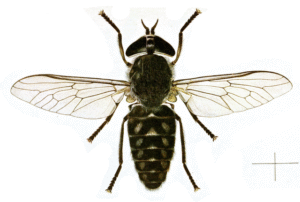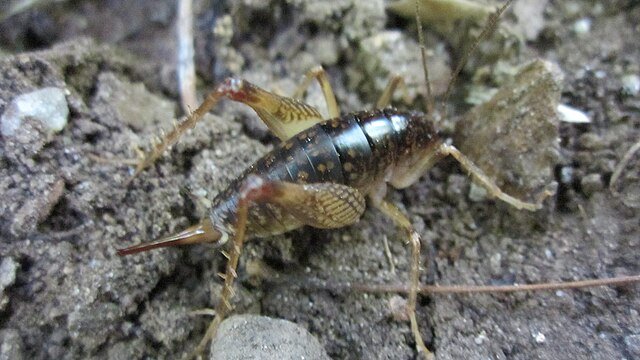Horse Flies (Tabanus spp.): Identification, Dangers, and Control Explained
 Few insects annoy both humans and animals as much as horse flies (Tabanus spp.). If you have ever been bitten by one, you know exactly what I mean. Their bite is painful, leaves a swollen mark, and sometimes even bleeds. As a pest control expert, I often get calls from stables, farms, and even lakeside cafés during summer asking, “How do we get rid of these huge biting flies?”
Few insects annoy both humans and animals as much as horse flies (Tabanus spp.). If you have ever been bitten by one, you know exactly what I mean. Their bite is painful, leaves a swollen mark, and sometimes even bleeds. As a pest control expert, I often get calls from stables, farms, and even lakeside cafés during summer asking, “How do we get rid of these huge biting flies?”
In this article, I’ll explain how to identify horse flies, understand their biology, and apply practical control strategies. I’ll keep it simple, direct, and based on what works in real life—not just what’s written in entomology books.
Identification of Horse Flies
Horse flies belong to the family Tabanidae. There are over 4,000 known species worldwide, and many look slightly different, but they share common traits.
Appearance:
Size: Usually 10–25 mm, some species over 30 mm.
Color: Brown, grey, or black body, often with striped thorax or colored eyes.
Wings: Transparent or slightly smoky, always large and powerful.
Eyes: Big and bright—sometimes green, purple, or golden.
Mouthparts: Females have strong cutting mouthparts for blood-feeding. Males feed only on nectar.
Because of their large eyes and fast flight, they are easily confused with deer flies (Chrysops spp.), but horse flies are bigger and noisier.
Biology and Ecology
Horse flies are strong fliers and skilled hunters. Unlike mosquitoes, they do not use a needle-like mouth. Female horse flies slice the skin and feed on the blood that flows out.
Feeding behavior: Females need blood to develop eggs. Males feed only on nectar or plant juices.
Hosts: Cattle, horses, deer, and sometimes humans.
Activity: Most active during warm, sunny days. They prefer humid environments—near lakes, rivers, and pastures.
Egg laying: Females lay eggs on vegetation near water. A single female can lay 100–1,000 eggs.
Lifecycle: Egg → Larva → Pupa → Adult. The larval stage lives in moist soil or mud, feeding on small insects or decaying matter.
They play some ecological role in pollination, but their main impact is as biting pests.
Global Distribution
Horse flies are found almost everywhere in the world except extreme polar regions. Their abundance depends on climate and humidity.
North America: Very common during summer; species like Tabanus atratus (black horse fly) are widespread.
Europe: Present from Scandinavia to the Mediterranean. Farmers know them well during hot months.
Australia: Both native and introduced species; they cause problems for livestock.
Asia: Large populations in tropical and subtropical zones, especially near rice fields.
Africa and South America: Common in wet savannas and rainforests.
Essentially, wherever you find warm weather and animals, you will find horse flies.
Risks and Damage
Horse flies are not just annoying—they are medically and economically important.
1. Painful Bites
The bite of a female horse fly is extremely painful. They cut the skin with sharp mouthparts and feed on exposed blood. The saliva they inject contains anticoagulants, causing redness, swelling, and itching.
2. Disease Transmission
While not as efficient as mosquitoes, horse flies can transmit pathogens:
Tularemia (Francisella tularensis)
Anthrax (Bacillus anthracis)
Equine infectious anemia virus (EIA)
Trypanosoma species (in livestock)
3. Impact on Animals
Livestock suffer more than humans. Constant biting leads to:
Stress and restlessness
Reduced feeding and milk production
Weight loss
Open wounds prone to infection
4. Economic Damage
In dairy farms and horse stables, infestations can lead to financial losses due to lower productivity and veterinary costs.
Signs of Infestation
Horse flies don’t hide indoors like bed bugs or fleas. They are usually noticed during outdoor activity.
Typical signs include:
Large flies circling or chasing animals.
Persistent biting during daytime.
Restless livestock constantly flicking tails or moving away from sunlight.
Near water sources: larvae can be found in wet soil or decaying vegetation.
If you see big, fast, buzzing flies that attack during hot days—most likely, you’re dealing with horse flies.
Control Methods
Horse fly control requires patience. Because they breed outdoors and travel long distances, full elimination is difficult. But you can reduce their numbers significantly.
1. Environmental Management
Drain standing water or mud near barns and homes.
Mow tall grass and remove decaying vegetation.
Clean manure and compost piles regularly.
Keep livestock areas dry and well-ventilated.
2. Physical Barriers
Fly masks and blankets for horses and cattle.
Screens and fans in barns and stables—horse flies dislike strong airflow.
Sticky traps or specialized H-traps that use dark targets and attractants.
3. Repellents
Products with DEET, picaridin, offer short-term protection.
Natural repellents: essential oils from citronella, eucalyptus, or lavender can help but need reapplication.
4. Chemical Pest Control
In large-scale operations:
- Call a licensed professional
Residual sprays around barn entrances or shady resting areas.
Larvicides in standing water (only by professionals).
Always follow local pesticide regulations.
5. Biological Control
Predators such as dragonflies, spiders, and certain wasps naturally help keep populations lower. Encouraging biodiversity in farms can assist long-term management.
Advanced Approaches
For farms or facilities that face recurring horse fly problems, integrated methods work best.
Integrated Pest Management (IPM)
IPM combines monitoring, sanitation, biological control, and limited chemical use. The goal is prevention, not just killing.
Trap Optimization
Use dark, moving objects to attract horse flies.
CO₂ baiting traps can improve efficiency.
In hot climates, some farmers use large ball traps covered in sticky material near pastures.
Technology and Research
Infrared light traps are now being tested.
Some studies explore pheromone-based attractants to lure females before egg laying.
The focus is shifting from spraying chemicals to targeted, sustainable control.
Cultural and Historical Context
Horse flies have bothered humans for thousands of years. In ancient texts, they are described as “blood-sucking tormentors of cattle.” The Greeks even had a myth about a horsefly sent by Hera to sting Heracles’ horses.
In rural communities, horse flies are often called “gadflies” or “bull flies.” Despite their bad reputation, they are part of the natural ecosystem, helping recycle organic matter and pollinate certain plants.
Still, when populations explode, control is necessary—for comfort, safety, and animal welfare.
Frequently Asked Questions (FAQ)
1. Do horse flies bite humans?
Yes, only females bite. They cut the skin to feed on blood needed for their eggs.
2. Are horse fly bites dangerous?
Most bites cause pain, swelling, and itching. However, secondary infections can occur, and in rare cases, diseases can be transmitted.
3. How can I treat a horse fly bite?
Wash with soap and water, apply antiseptic, and use cold compress. Antihistamine cream helps reduce itching.
4. Can horse flies enter houses?
Sometimes, especially if attracted by light or food smells, but they prefer outdoor environments.
5. What attracts horse flies?
Movement, dark colors, CO₂, and sweat. That’s why they target animals and humans during outdoor activities.
6. Do horse flies serve any purpose?
Yes, males help pollinate plants. Larvae break down decaying organic matter in soil.
7. How can farmers control horse flies without chemicals?
Maintain dry surroundings, use fly masks, traps, and ensure good animal hygiene.
8. What is the difference between horse flies and deer flies?
Deer flies (Chrysops spp.) are smaller, with patterned wings, but also bite. Horse flies are larger and more persistent.
Final Thoughts
After treating many farms, stables, and outdoor facilities, I can say one thing with confidence: horse flies (Tabanus spp.) are among the toughest flying pests to deal with. They are strong, fast, and persistent. But control is absolutely possible if you understand their habits and work systematically.
Start with the basics—reduce standing water, clean organic debris, and use physical protection like fly masks and traps. Avoid relying only on chemical sprays; they bring short relief but don’t solve the root cause. In most cases, combining environmental management, repellents, and mechanical control gives the best long-term results.
If you run a farm, stable, or outdoor café near water, regular monitoring is key. Horse flies reproduce quickly in moist conditions, so prevention saves money and frustration later.
Remember: these insects are not evil—they are part of nature’s system. The goal is balance, not eradication. You want comfort and safety for animals and people, without harming the environment.
Disclaimer
This article is for informational purposes only. Pest control laws and approved chemicals vary by country. For best results and legal safety, we strongly recommend contacting a licensed pest control professional in your local area. Always make sure that the pest control technician is properly certified or licensed, depending on your country’s regulations. It’s important to confirm that they only use approved products and apply them exactly as instructed on the product label. In most places in Europe, the UK, or the USA, following label directions is not just best practice—it’s the law.
Author Bio
Nasos Iliopoulos, BSc Agronomist & Certified Pest Control Expert
Scientific Director – Advance Services (Athens, Greece)
Licensed Pest Control Business – Ministry of Rural Development & Food (GR)
References
University of Kentucky - Horse Flies and Deer Flies

